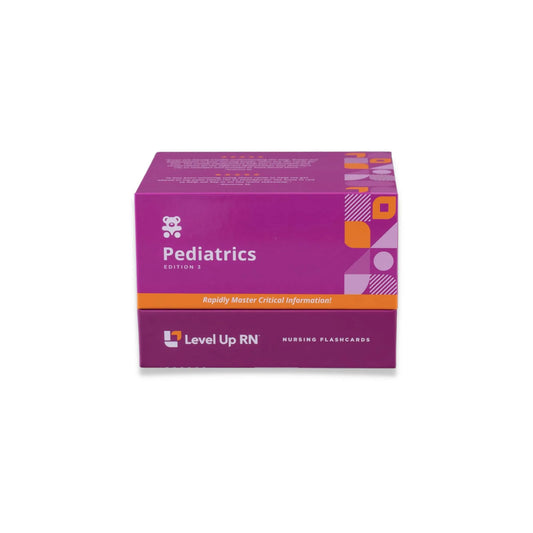Hi, I'm Cathy with Level Up RN. In this video, I will be discussing acute kidney injury, or AKI, as well as chronic renal failure, which is also known as chronic kidney disease or CKD. At the end of the video, I'm going to give you guys a little quiz to test your knowledge of some of the key points I'll be covering. So definitely stay tuned for that. And if you have our Level Up RN pediatric nursing flashcards, go ahead and pull out your flashcards so you can follow along with me and pay close attention to the bold red text on these cards because those are the things that you are likely to get tested on on your nursing school exams.
Acute kidney injury or AKI is the sudden loss of kidney function that is typically reversible. So this is different than chronic kidney disease, which is the gradual and irreversible loss of kidney function. So AKI can be caused by prerenal causes, intrarenal causes, and post-renal causes. So prerenal causes are things that decrease blood flow to the kidneys, such as shock, for example. Intrarenal causes are things that cause direct damage to the kidneys, such as a nephrotoxic medication. And then post-renal causes include things that obstruct outflow of urine from the kidneys. So an example would be an anatomic abnormality. Signs and symptoms of AKI include oliguria, so a decrease in urine output during the oliguric phase, followed by polyuria, which is an increase in urine output during the diuretic phase. So during the oliguric phase, because the patient is not urinating very much and is retaining all of that fluid, we will have signs and symptoms of hypervolemia such as edema and hypertension.
In terms of labs you would expect with AKI, creatinine and BUN will be elevated due to kidney dysfunction. And then electrolyte imbalances that are often present include hyperkalemia, which places the patient at increased risk for dysrhythmias as well as hypocalcemia and hyponatremia, which occurs because sodium is being diluted with all of that extra fluid that is being retained. AKI can also cause metabolic acidosis as well as anemia. So anemia occurs because we have decreased production of erythropoietin in the kidneys, which is required for red blood cell production. Treatment of AKI includes addressing the underlying cause, administering diuretics to get rid of all that excess fluid, administering antihypertensive agents to bring down the child's blood pressure, and administering medications to bring down potassium levels, such as Kayexalate. And then severe cases of AKI may necessitate dialysis. So as the nurse, you want to implement seizure precautions due to hyponatremia. You also want to closely monitor your patient's intake and output as well as their daily weight. And then you want to provide a diet that is low in potassium, sodium, and phosphorus as ordered by the provider.
Moving on to chronic renal failure now, which, as I mentioned before, is the gradual and irreversible loss of kidney function. Risk factors for chronic kidney disease include kidney birth defects, hereditary diseases such as polycystic kidney disease, infections such as glomerulonephritis, nephrotic syndrome, as well as systemic diseases such as diabetes. Some of the signs and symptoms of chronic renal failure include decreased appetite, headaches, nausea and vomiting, edema, hypertension, uremic frost, which is where we have crystallized urea deposits on the skin, pruritus, which is a fancy name for itching, as well as increased bruising and poor growth. In terms of labs, you would expect to be present with chronic renal failure, many of these labs are the same things we talked about with AKI. So creatinine and BUN will be elevated due to kidney dysfunction. Electrolyte imbalances that are often present include increased levels of potassium and phosphorus, as well as decreased levels of calcium and sodium. So with sodium, we have dilutional hyponatremia that often occurs. And then anemia is also often present with CKD because we have decreased levels of erythropoietin being produced by the kidneys.
Medications used to treat chronic renal failure include diuretics to get rid of excess fluid, epoetin alfa to treat anemia, a phosphorus binding agent to bring down levels of phosphorus, antihypertensive agents to help bring down the blood pressure, as well as calcium and vitamin D supplements. And then for end-stage kidney disease, dialysis, or a kidney transplant will become necessary. In terms of nursing care, you'll want to monitor your patient's intake and output as well as their daily weight. And then dietary restrictions for a child with chronic renal failure will really depend on a number of factors. So potassium and phosphorus intake is usually restricted. And then the child's sodium and fluid intake may also be restricted in order to control their blood pressure. And then protein intake may also be restricted within a certain range, depending on whether the child is receiving dialysis or not.
All right. It's quiz time, and I've got five questions for you this time because we went over a lot of important information.
Question number 1, what acid-base imbalance is typically present with AKI or CRF?
The answer is metabolic acidosis.
Question number 2, why is a patient with AKI at risk for dysrhythmias?
The answer is due to the presence of hyperkalemia.
Question number 3, blank is the presence of crystallized urea deposits on the skin that may occur with CRF.
The answer is uremic frost.
Question number 4, why is anemia present with AKI and CRF?
The answer is kidney dysfunction causes a decrease in erythropoietin production, which is required for red blood cell production.
Question number 5, should potassium and phosphorus intake be increased or decreased with AKI and CRF?
The answer is decreased.
All right. I hope you did great with that quiz, and I hope you learned a lot from this video. Take care, and thank you so much for watching.


